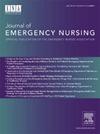曼彻斯特分诊系统作为儿科急诊室早期置入外周静脉导管的预测模型:一项横断面研究
IF 2.3
4区 医学
Q2 EMERGENCY MEDICINE
引用次数: 0
摘要
简介:外周静脉置管是儿科急诊科常见的手术。然而,这些导管的相当大比例仍然未使用,分诊系统可以潜在地预测导管的使用。因此,本研究旨在将儿童外周静脉导管的使用与咨询原因和根据曼彻斯特分诊系统分配的优先级别联系起来。方法:在西班牙埃尔切Vinalopó大学医院急诊科进行横断面描述性研究。对2010年至2024年3月0 ~ 14岁患者的病历进行分析。该研究包括在住院期间放置外周静脉导管的儿童。结果:45%的患者置管后未使用外周静脉导管。咨询原因与导管使用的优先级之间存在显著关系(p讨论:在儿科急诊服务中放置的近一半外周静脉导管可能仍未使用。然而,它们更常用于因“呕吐”、“儿童腹痛”和“肢体问题”等咨询原因而被分类的儿童,以及那些被分配为黄色优先级的儿童。本文章由计算机程序翻译,如有差异,请以英文原文为准。
Manchester Triage System as a Predictive Model for Early Placement of Peripheral Venous Catheters in a Pediatric Emergency Department: A Cross-Sectional Study
Introduction
Peripheral venous catheterization is a frequent procedure in pediatric emergency departments. However, a substantial percentage of these catheters remain unused and triage systems could potentially predict catheter utilization. Therefore, this study aimed to correlate the utilization of pediatric peripheral venous catheters with the reason for consultation and the priority level assigned according to the Manchester triage system.
Methods
A cross-sectional descriptive study was conducted in the emergency department of Vinalopó University Hospital, Elche, Spain. Medical records of patients aged 0 to 14 from 2010 to March 2024 were analyzed. The study included children who had a peripheral venous catheter placed during their stay in the department.
Results
In 45% of the cases, the peripheral venous catheter was not used after placement. Significant relationships were identified between the reason for consultation and the priority level with catheter utilization (P<.001). Catheters were most frequently used in children presenting with “vomiting” (73.9%), “abdominal pain in children” (62%), and “limb problems” (59.1%). Regarding priority, catheters were more commonly used in children triaged as yellow (urgent priority) (56.2%).
Discussion
Nearly half of the peripheral venous catheters placed in pediatric emergency services may remain unused. Nevertheless, they are more frequently used in children triaged for the consultation reasons of “vomiting,” “abdominal pain in children,” and “limb problems” and those assigned a yellow priority.
求助全文
通过发布文献求助,成功后即可免费获取论文全文。
去求助
来源期刊
CiteScore
3.10
自引率
11.80%
发文量
132
审稿时长
46 days
期刊介绍:
The Journal of Emergency Nursing, the official journal of the Emergency Nurses Association (ENA), is committed to the dissemination of high quality, peer-reviewed manuscripts relevant to all areas of emergency nursing practice across the lifespan. Journal content includes clinical topics, integrative or systematic literature reviews, research, and practice improvement initiatives that provide emergency nurses globally with implications for translation of new knowledge into practice.
The Journal also includes focused sections such as case studies, pharmacology/toxicology, injury prevention, trauma, triage, quality and safety, pediatrics and geriatrics.
The Journal aims to mirror the goal of ENA to promote: community, governance and leadership, knowledge, quality and safety, and advocacy.

 求助内容:
求助内容: 应助结果提醒方式:
应助结果提醒方式:


